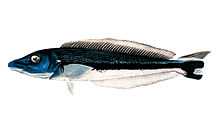Blue blanquillo
| Blue blanquillo | |
|---|---|
 | |
| Conservation status | |
| Not evaluated (IUCN 3.1) | |
| Scientific classification | |
| Kingdom: | Animalia |
| Phylum: | Chordata |
| Class: | Actinopterygii |
| Order: | Perciformes |
| Family: | Malacanthidae |
| Genus: | Malacanthus |
| Species: | M. latovittatus |
| Binomial name | |
| Malacanthus latovittatus (Lacépède, 1801) | |
| Synonyms [1] | |
| |
The blue blanquillo, Malacanthus latovittatus (also known as the banded blanquillo, striped blanquillo, false whiting, sand tilefish or eye of the sea), is a species of tilefish from the family Malacanthidae.[2] The fish is known to swim at depths of 20–22 metres (66–72 ft) with temperatures of 22–28 °C (72–82 °F).[3]
Description
The blue blanquillo is one of the many members of the Malacanthidae family, which are distinguishable by their streamlined bodies and the large crest on their head. The fish is primarily blue, with some shades of yellow, and can change colour in different situations. on their backs, there is a series of stripes that run across its body. Their belly is white and the head colour changes from a light blue to a pinkish mix during spawning season.
Taxonomy
The Blue blanquillo is the only species within the genus Malacanthus, which itself is in the family Malacanthidae, commonly known as tilefish. The Malacanthidae are part of the Percoidea, a suborder of the order Perciformes. Both subfamilies have relatively long dorsal fins and anal fins.[4]
Distribution and origins
Blue blanquillo fish are commonly found in the Indo-Pacific area, ranging from the Red Sea to the Line Islands, north to southern Japan and south to New Caledonia and the Cook Islands. They are often seen in areas around coral reefs near the sea floor. This particular species gets its name from its bluish coloration.[5]
Behaviour
Malacanthus latovittatus does not swim in schools, they are often found swimming alone or in pairs.[6] They are known to clean other fish, but may mimic the wrasse to inhibit predators from eating it.[7] They tend to swim high above the substrate to pick prey from the substrate with their excellent eyesight.[8]
Ecology
The blue blanquillo's primary staple is benthic invertebrates or zooplankton, but they also feed on crustaceans such as crabs and shrimp, molluscs, worms, sea urchins and small fish.[9] Their common predators are reef sharks, and other larger fish; they are also eaten by humans.
References
| Wikimedia Commons has media related to Malacanthus latovittatus. |
- ↑ Nicolas Bailly (2013). "Malacanthus latovittatus (Lacepède, 1801)". In Nicolas Bailly. FishBase. World Register of Marine Species. Retrieved May 24, 2013.
- ↑ "The Blue Blanquillio". whatsthatfish.com. Whats That Fish?. Retrieved 23 May 2013.
- ↑ Baensch, Henrich (1997). Meerwasser atlas. Mergus Verlag GmbH, Postfach 86, 49302, (in German). Melle, Germany: Mergus Verlag GmbH, Postfach 86. p. 1216.
- ↑ "Malacanthidae (Tilefishes)". Digital Fish Library. DFL. Retrieved 24 May 2013.
- ↑ "CAS Cataloge of Fishes". CAS. California Academy of Science. Retrieved 24 May 2013.
- ↑ Tamiea, Tonozuka (2001). Pictorial guide to Indonesian reef fishes. Part 1. Eels- Snappers, Muraenidae - Lutjanidae. Zoonetics, Australia.. Australia. pp. 302, 292.
- ↑ Lieske, Edward (1994). Collins Pocket Guide. Coral reef fishes. Indo-Pacific & Caribbean including the Red Sea. England: Haper Collins Publishers. p. 400.
- ↑ John, Dooley (1978). Systematics and biology of the tilefishes (Perciformes: Branchiostegidae and Malacanthidae) with descriptions of two new species. NOAA Tech. Rep. p. 411.
- ↑ "Malacanthus latovittatus". NOAA.gov. NOAA. Retrieved 24 May 2013.